

How to Get a Driver’s License in Thailand: Guide for Foreigners
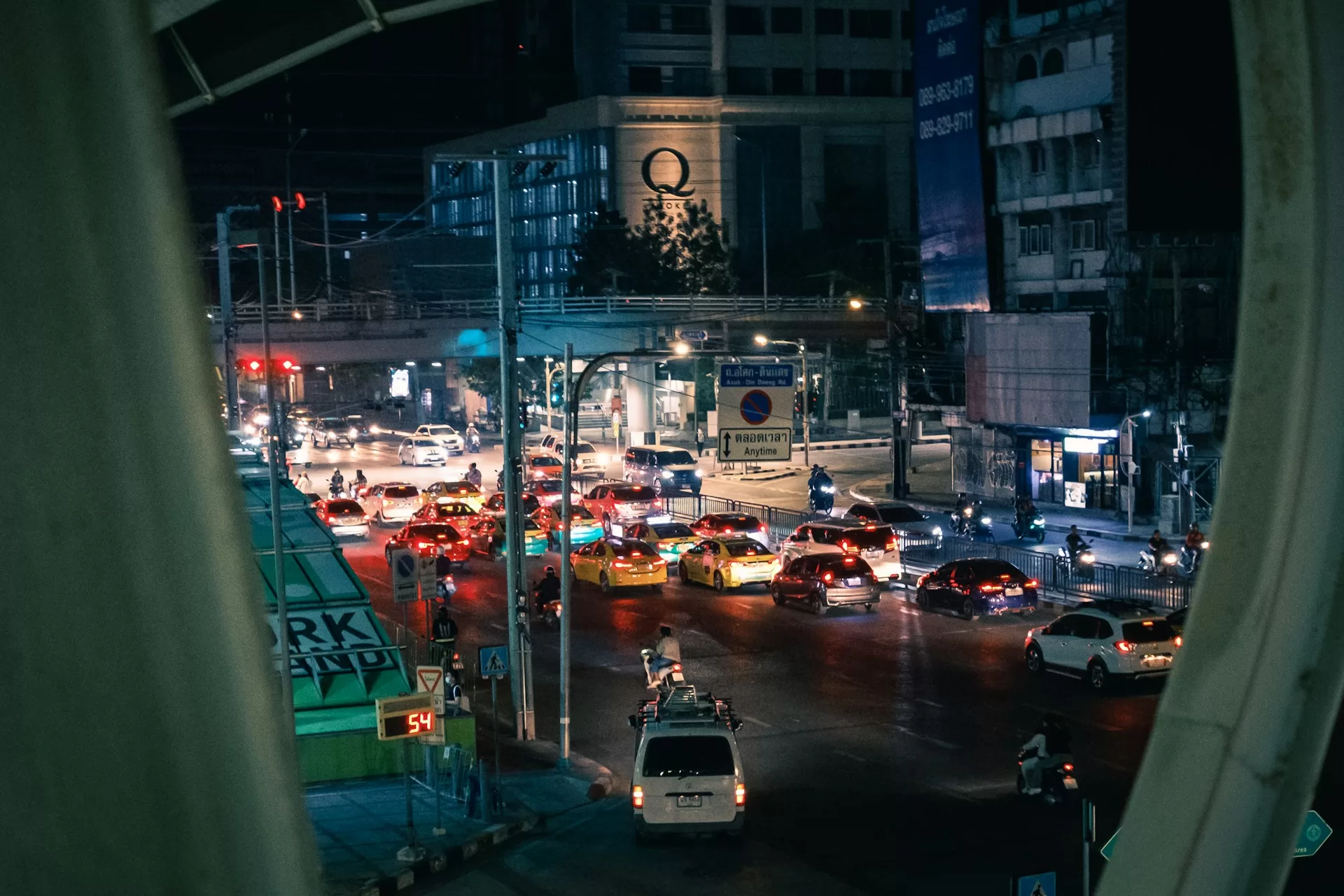
Many foreigners move to Thailand and–unsurprisingly–want to have the convenience of driving around whether it be by motorbike or car.
Driving in Thailand, however, comes with quite a steep learning curve . It demands a practical understanding of the local traffic regulations and–of course–the acquisition of a Thai Driver’s License. If you’re familiar with Thailand at all, you’ll know that dealing with bureaucracy in the country is never simple.
In this guide, we’ll walk you through the process of obtaining a driving license in Thailand as a foreigner, making your journey on Thailand’s motorbike-filled roads both legal and enjoyable.
It’ll also save you a lot of hassle from Thai police.
Understanding the Basics of Driving in Thailand
Before we dive into the intricacies of obtaining a driver’s license in Thailand, let’s establish a foundational understanding of driving in Thailand, which can be very different than driving in the West.
Here are a few tips for driving safely in Thailand:
- Thailand follows left-hand traffic, so stay on the left side of the road.
- Traffic is a fact of life in urban areas like Bangkok. Expect it, especially during rush hours.
- Motorbikes are everywhere. Keep an eye out for them, as they may weave through traffic unpredictably.
- Thais often use horns as a form of communication, not just to signal frustration. Don’t be alarmed; it’s a common practice.
- Pedestrians may not always use crosswalks, so be vigilant, especially in busy areas.
- Random traffic police checkpoints are common. Ensure you have all required documents, including your driver’s license, ready for inspection.
What are the Requirements to Obtain a Thai Driver’s license?
In general, the requirements for a Thai driving license is pretty similar to the standards in other countries. You’ll need to be gather all the necessary documents such as your passport and visa, apply at a Department of Land Transport office, and–of course–pass both the theory and practical driving exams.
How Can I Apply for a Thai Driver’s License?
Now that is out of the way, let’s explore the step-by-step process of obtaining a permanent Thai driving license.
Step 1: Obtain a Non-Immigrant Visa
To qualify for a Thai Driver’s License, you must first be on a non-immigrant visa. Put simply, this is a type of visa that gives you permanent residency in Thailand. Examples of this are education visas in the Kingdom as well as visas that go along with a work permit. Foreigners on tourist visas (even long-term tourist visas ) aren’t accepted.
Step 2: Acquire a Certificate of Residence
Before initiating your driving license application in Thailand, acquire a Certificate of Residence from your local immigration office. This document serves as a confirmation of your address in Thailand and is a vital component of your license application.
Step 3: Assemble Required Documents
For things to go smoothly in the process of getting your license, it’s important to gather the necessary documents beforehand:
- Valid non-immigrant visa
- Certificate of Residence
- Your home country’s driver’s license (if applicable)
Step 4: Undergo a Medical Examination
Visit a certified hospital or clinic in Thailand for a routine medical examination. The medical certificate attests to your physical fitness to drive and is a standard requirement in the licensing process.
Step 5: Submit Your Application
Head to the nearest Department of Land Transport (DLT) office and submit your application. Expect to take a written test on traffic rules and signs. If you’ve attended a driving school, this phase should be relatively straightforward. Successful completion of the written test paves the way for the practical driving examination.
Step 6: Attend Training and Take Written Test
Following completion of a comprehensive 5-hour training program, prospective motorists will have to take a 50-question exam electronically. To successfully pass the examination, applicants must score at least 90% (45 out of 50 questions correct).
Step 7: Take the Practical Driving Test
The practical driving test is the final hurdle on your path to obtaining a driver’s license in Thailand. Your ability to drive safely and adhere to traffic regulations will be evaluated. Forward and backward driving is tested as well as other driving maneuvers and parking skills.
Expats who want to get a motorbike license in Thailand will have to prove their riding proficiency by consistently riding in a straight line through traffic cones.
Is it Possible to Convert My Foreign Driver’s License to a Thai Driver’s License?
Short answer: yes. Converting a foreign driving license to a Thai driver’s license also bypasses the requirements to take both the written and practical driving tests. Applicants must bring their passport, foreign driver’s license (with an official embassy translation to english if necessary), proof of residence in Thailand, and a medical certificate.
Get on the Road in Thailand
As you can see, obtaining a Thai driver’s license isn’t all that difficult. However, the language barrier and realities of bureaucracy in the country can bring up quite a few unforeseen headaches. Just be patient and remember to always have the required documents on hand while preparing yourself for the next step in the process.
Things to do ↗
Find the best activities, restaurants, and nightlife in Thailand.
Destinations ↗
Explore the endless destinations Thailand has to offer.
Stay in Thailand ↗
Learn how to extend your stay in the Land of Smiles.
Get personalized trip plans to Thailand that fit your budget and interests
Thailand explained.
Privacy Policy
Terms of Service

Foreigners Driving in Thailand: A Brief Guide to Help You Navigate The Roads of Thailand
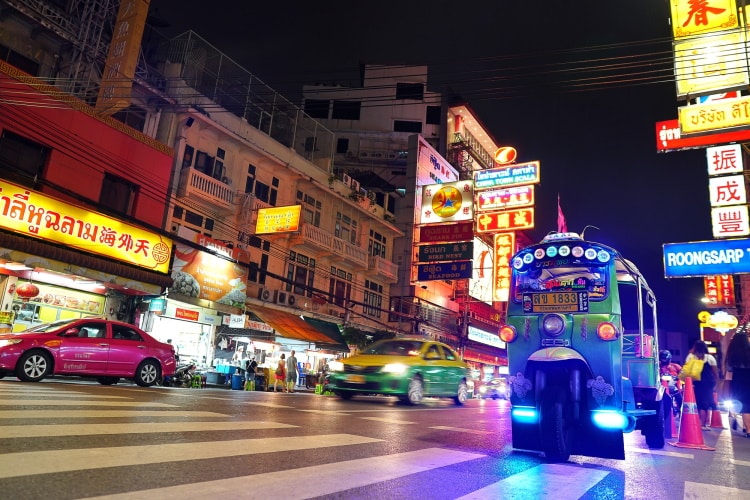
Many visitors to Thailand are probably either too jet lagged or too excited to be paying that much attention to what might seem like minor details of their cab journey to the hotel. But the way the taxi ride from the airport goes can often provide valuable insights to the way people drive on the roads in a country.
The above statement is especially true and important for anyone who may be considering driving in Thailand to note and requires much further investigation.
License Requirements for Foreigners
If a foreigner is staying in Thailand on a tourist visa then by law a driver should have carry their National Drivers License (in English or translated to English), and an International Driving Permit (obtained easily in your home country – if your country qualifies). Some sources state a National Driving License will suffice, however, following advice like this which states foreigners should carry an International Driving Permit is best to follow.
For foreigners living in Thailand on a Non-Immigration Visa, they need to be holding a Thai Driving License.
How Do Roads and Drivers in Thailand Compare to Those in Western Countries?
The first thing to consider is any similarities followed by the differences compared to driving in your own country. Vehicles drive on the left in Thailand and speed limits, although largely ignored (I kid you not ), are shown in kilometres per hour. Road signs are mostly expressed in both Thai language and English on main roads.
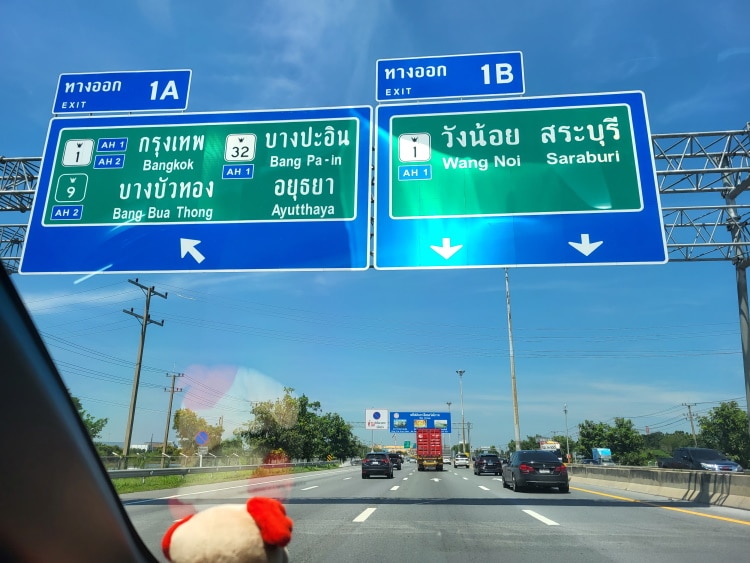
Drivers bred or experienced in Western countries and thus familiar with the strict training and driving regulations that are even more strictly enforced may start to notice the subtle differences on Thai roads from the offset. This is usually followed by a gradual dawning of the much less subtle aspects.
It could come by way of your taxi driver from the airport not stopping at traffic lights. This might be further fuelled by the somewhat puzzling realisation that your driver also seems oblivious to anyone attempting to use an indicator when trying to change lanes.
In fact, it seems that both your driver and what looks like many other road users are simply switching lanes and making turns without any apparent attempt at indication—or in some cases the opposite occurs whereby the wrong indicator is being used (mostly unwittingly and very commonly).
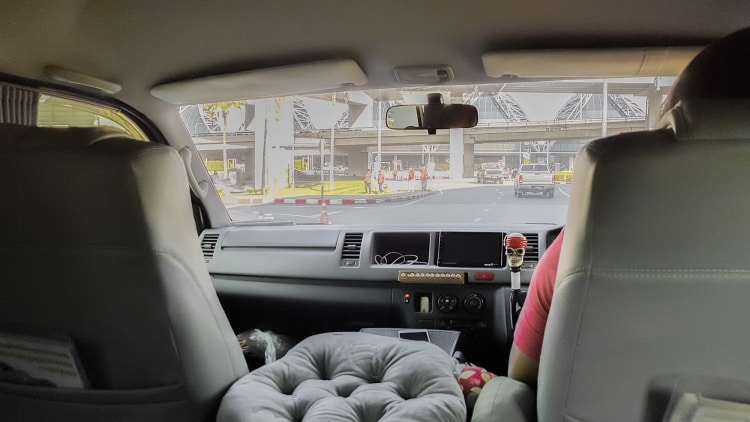
The indicator issue is no small thing in itself and is kind of complex too—so more on that later. For now we’ll just say that bearing witness to just a couple of these routine instances on the roads in Thailand should be enough to horrify even the most seasoned of potential drivers in the country who originate from elsewhere.
Aside from the indicator issue, it’s also commonplace to witness many of the drivers in Thailand indulging in some (or maybe even all) of the following:
- Total ignorance of traffic lights and any other signs
- Total ignorance of what may or may not be the signals of other drivers (how do you ever truly know ?)
- Talking on the mobile phone behind the wheel
- Doing a spot of online shopping
- Scrolling social media feeds
- Watching a movie on their phone
- Eating and drinking
- All of the above
I kid you not .
And please don’t think this is an attempt to paint an overly-negative picture of Thailand or its road-users. The observations and comments of most people in the country including locals will confirm this, as will proportional local statistics like the ones depicting the 7 day new year period in Thailand, and Songkran (Thai new year) which can go on for between 3 and 7 days.
This is the time of year when accidents are at their peak and can reach as many as 400-plus. In 2020 the figures were down to 373 fatalities for this period although the figures for accidents alone can be in excess of 3,000 throughout this time when revelry and drunkenness is rife!
Figures are always going to be conflicting according to how and where they have been gathered, though. To put that into perspective we might consider other figures like those published by the World Health Organization putting Thai roads at some of the deadliest in the world with actual figures closer to 20,000 deaths in road accidents each year, which is the equivalent to around 56 deaths per day !
The bottom line is that Thailand has some of the worst road traffic accident statistics in SE Asia, and is commonly in the top 3-5 out of all countries in the region.
OK. And what’s this about Indicators?
Okay. Let’s first consider the ‘learning’ and ‘testing’ procedures for qualifying for a driving licence as a native in Thailand. (You can read about the process of foreigners getting a driving licence in Thailand HERE .)
The fact is that the driving ‘test’ isn’t done on the road here. There is no highway code to speak of—well there is in theory of course, but most drivers are oblivious to it in that they can bypass or avoid any knowledge of it or any other driving issues related to safety completely.
A testing centre scenario will largely be about turning on the engine of a car and making it go forwards and backwards. Not too much going on by way of noticing or learning the importance of mirrors and indicators—probably the 2 things that most Westerners are likely to fail a driving test on in their own country!
Thus the process is more commonly than not accomplished with the simple greasing of a receptive palm. ‘Nuff said. Culture rules.
The downside of this aspect of gaining a licence and getting behind the wheel of a potential killing machine means that you may well be largely driving on the same roads as people with little to no concept of either the road system, the operation of the vehicle, or any seeming awareness of other drivers compared to roads in Western countries.
This may sound like a harsh observation or even judgement but the fact is, the way that people drive here is a reflection of that initial test, which leaves them devoid of any real knowledge or experience before venturing out.
It’s also worth keeping in mind that a proportion of the driving population on the roads may not even be in possession of anything looking like a valid licence, let alone insurance. Reality check, look out then.
What about the Roads and Rules in Thailand?
Roads in Thailand range from multi-lane freeways around Bangkok to tiny back streets and lanes known as soi . Frequently-used roads in the provinces can also be up to four lanes wide.
Due to the sporadic yet ongoing attempts at upgrading or constructing new roads throughout the nation, roadworks tend to be commonplace. The rainy season can get the better of many of them as they flood and turn messy.
Suburban streets are similar in some ways to those in the rest of the world but don’t expect the same road quality which can make any trip seem way more bumpy than you might imagine.
Speed limits, marked by signposts, are between 50 Km/h and 60 Km/h. Some small lanes have speed bumps to reduce speed and danger to pedestrians. Check all signs for changes to the usual speed limit of 60 Km/h.
Road Sense and Etiquette in Thailand
If you spend any amount of given time in Thailand observing the driving, there’s a good chance that sooner rather than later you start to get the impression that any concept of road sense or driving etiquette even exists—let alone any acknowledgement or awareness of road signs, road markings, or any apparent (or non-apparent) laws. Culture only rules.
Of course this will depend where it is you are from, but the harsh fact is there is a massive culture shock waiting on the roads of Bangkok for any non-native intending to get behind the wheel—even with all good intentions (or as we shall see especially when with good intentions).
Don’t expect any giving way (anywhere) and this includes stopping at zebra crossings, which are largely pointless.
Embracing a Sense of Freedom and Adventure
Seemingly there will always be those adventurous spirits who push on regardless, determinedly oblivious to the danger, chaos, and confusion that awaits and surrounds them on some roads They may even be intent on conquering it.
This could come from a strong sense of adventure, or even a well-intentioned effort to get a ‘grass-roots view of the city’ and blend into the surrounding environment like a local. It could also be anyone with a family who has seen the impracticality and infeasibility of the city’s public transportation system. They may thus decide to ‘dig in’ and make the bold decision to navigate the expanse of the city under their own steam.
And indeed these are noble and admirable approaches to navigating any land worth a visit across the globe. We do hope, however, that by deeming to offer advice based on the reality of the driving landscape in Thailand based on observation and experience that we are able to make any driving efforts within the land of smiles that much smoother for said adventurous types.
Be Aware of These When Navigating the Roads in Thailand
To put a fine point on it, there are lots of accidents on the roads in Thailand. How you choose to deal with that when making the decision to drive in this country will ultimately be your own lookout.
If you spend any amount of time in the country, you will find that the majority (if not all) of car drivers have either been involved in some kind of accident, or expect to be!
Food for thought indeed. Many foreigners try to combat the situation through a demonstration of ‘proper’ driving, following the rules of the road, giving way, and generally making a nuisance of themselves to other drivers on the road. Eventually they will adopt a different attitude or give up completely after a few days.
There are many reasons Thailand has one of the highest instances of road traffic accidents and deaths on the road in the world. Some of the factors are related to culture, economics, education, a high degree of drunk driving, and the Thai driving test which involves no ‘on-the-road’ driving to speak of (and which some people have even been known to pay someone else to take for them!).
If you happen to be from a Western country, you will come as something of a shock to realise just how little attention drivers on the roads in Bangkok pay to other drivers. This means that you WILL encounter drivers who don’t look before pulling out in front of you, along with those who don’t indicate when turning or changing lanes and always believe that they have the right of way, no matter what!
To confound things even further, you will also likely encounter plenty of drivers who are indicating when they have no intention of turning in that direction at all (they don’t know the indicator is still on) – and they often turn the opposite way!
You will meet vehicles (particularly other bikes) driving along the road in the wrong direction, along with others who randomly stop wherever they see fit. Look out!
A red light does not always mean stop in Bangkok. There is no sense of ‘courtesy’ on the road in Thailand, like there tends to be in countries where some form of Highway Code or etiquette is followed. Studying and exhibiting knowledge of The Highway Code or anything like it is not generally a requirement of the Thai driving test or acquiring a licence.
People do not give way, to the point where they don’t even stop at zebra crossings. So if you happen to be the one slowing down at a pedestrian crossing to let a mother with her child cross, you will either be the target of beeping horns behind you, or you may get run into from the back. Or both.
Apart from all that, it’s possible that for some, driving on the road could be a fun and adventurous way to make your way around when visiting. Maybe you can decide for yourself.
So Is It a Good Idea to Drive in Thailand?
The fact is, regardless of any exotic sense of adventure that many visitors come to the country armed with, driving in Thailand does not come highly recommended. And that’s on a number of levels, not just the opinion of someone who’s had enough first-hand experience of it to last ten lifetimes.
We are also talking in both local and statistical terms here. Ask a local about driving in Thailand and they will undoubtedly strongly advise against it, especially for foreigners. And look at statistics—not good when you consider them.
So neither of these aspects would suggest that getting behind the wheel and negotiating the roads in Thailand would exactly be a wise move. This would be most true in the vicinity of the culminating point of chaos personified when it comes to roads and traffic-flow—the capital, Bangkok.
Guess it’s your call. If you simply must drive in Thailand it’s best to exercise extreme caution and expect the unexpected, at all times. And if that still appeals to your sense of adventure, regardless, you’ll probably love it. Nevertheless, look out!

Mark Philip is a writer and lifestyle enthusiast from the Midlands in the U.K. With a background in martial arts and fitness, Mark upped sticks and headed out to Bangkok to delve a bit deeper into the art of Thai Boxing way back in the 2000s, starting to write initially to fund his daily training and escape the rigours of ESL teaching. Since then Mark has authored e-books, articles, and blogs across a wide range of topics for commercial, educational, factual, health & fitness, lifestyle, wellness, and leisure-based purposes.
- Transport In Thailand – Transportation Guide
- Thailand Taxi Advice and Tips
- Train Travel in Thailand – Guides for Tourists
- Bangkok Transport Guide – Getting Around Easily & Conveniently
- Tuk Tuks In Thailand – Tips and Advice
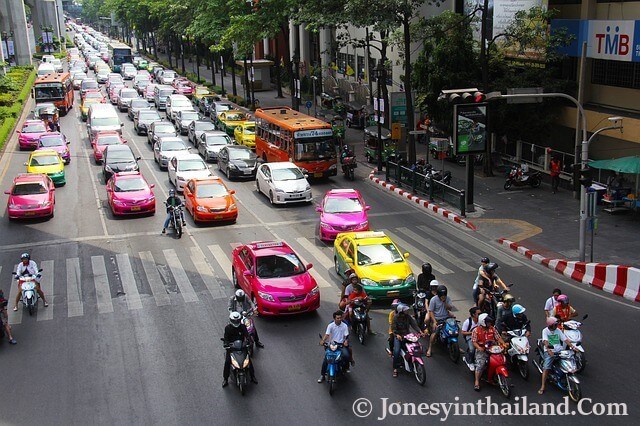
Bangkok Travel

Hua Hin Travel

Nong Khai Travel

Where To Go In Thailand? - Top Places To Visit
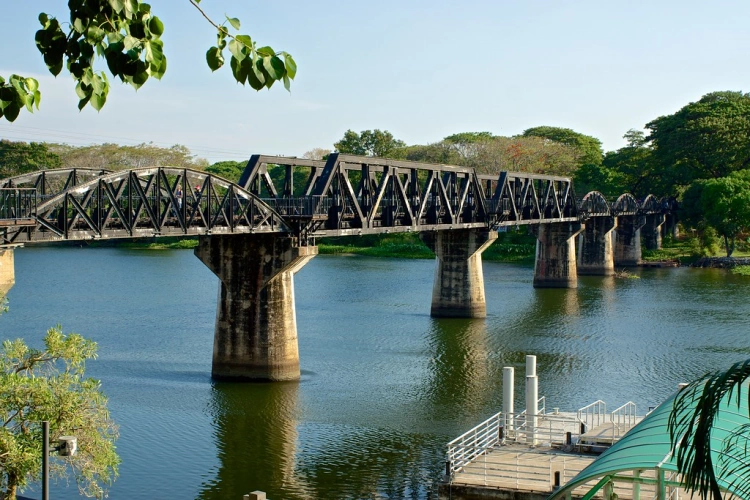
Kanchanaburi Travel
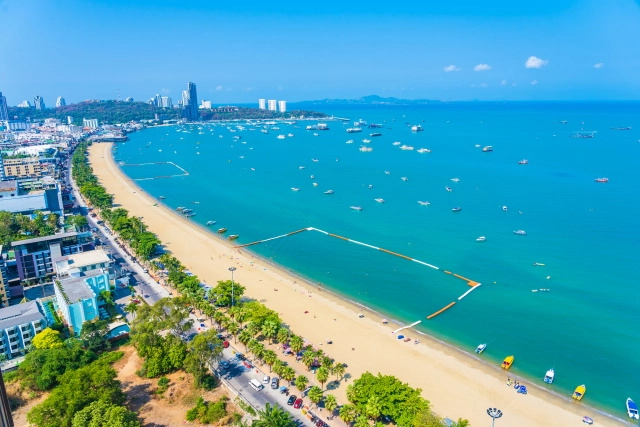
Pattaya Travel

Food of Thailand

Transport in Thailand

Driving in Thailand: Required Documents & Essential Safety Tips
If you're planning on driving on your holiday in Thailand, then you might be a little apprehensive – and rightly so.
If you're from a country where driving laws are well enforced, then you may be a little surprised at how often motorists ignore the road rules in Thailand.
I don't drive daily in Thailand, but I've had my fair share of experience on in-country holidays.
Of course, every country has its fair share of bad drivers, and it's not like I don't find myself swearing under my breath back home. The problem in Thailand is that for many years the test to obtain your driving license was so easy that it meant many inexperienced drivers took to the roads without ever really understanding the laws.
The actual test itself didn't involve any real driving on the roads, but rather simulated roads on derelict land – think driving in and out of cones. The test standards have got better in recent years, but driving standards remain poor.
If you drive cautiously and defensively, you will be fine. Just use your mirrors lots and always keep a good distance between yourself and the car in front; that way you will be able to anticipate any silly maneuvers such as turning off without signaling.
Anyway, before I give you some more detailed safety tips, let's have a look at what documents you need.
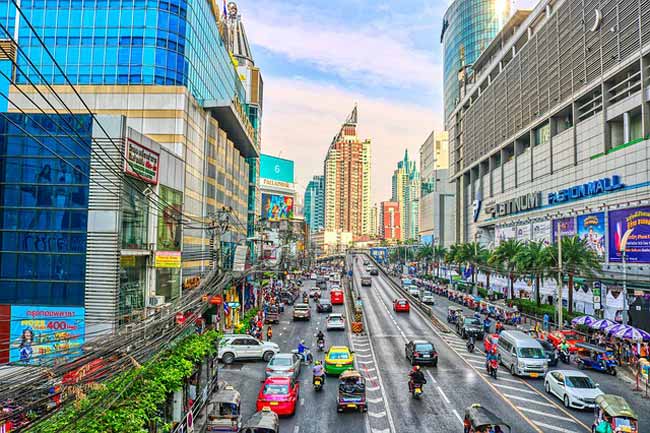
Pulling out of side turnings onto main roads can be difficult. Be bold!
Required Documents to Drive in Thailand
Thailand offers a diverse range of transportation options and you can pretty much always find a way to get around, and inexpensively, too.
However, many visitors find themselves drawn to the allure of riding a motorcycle to venture off the beaten path and embrace the freedom of independent transport. Similarly, driving a car also presents an attractive option, especially for families or those seeking a more comfortable and cooler mode of transportation.
Whether you opt for two wheels or four, being aware of the legal obligations for the correct documentation is crucial to avoid any complications and ensure a hassle-free holiday.
1. Valid Driver's License
It seems obvious, but you'd be surprised how many people forget to bring their license, or even try to hire a motorbike without one. Indeed, one hears stories back home about Thailand being a tad “wild west” and that rules here are easy to skirt around. This certainly isn't the case when it comes to hiring a bike or car.
I remember picking up my hire car about 5 years ago. I still had a paper driver's license, simply because I hadn't been back to the UK to apply for the newer photo ID version. Because the clerk hadn't seen one before, I was nearly refused hire and had to make a polite song and dance about it being a legitimate license.
In short: You must have a valid driver's license issued by your home country. The license should be in English or accompanied by an official translation.
2. International Driving Permit (IDP)
Few people realize you need an International Driving Permit (IDP). This is because you are rarely asked, especially when hiring a bike or a car – they usually just ask for a license.
I've been stopped at a police blockade on a few occasions and never been asked then either. But it is actually a requirement.
An International Driving Permit (IDP) is a document regulated by the United Nations. Many countries require an IDP for renting a motor vehicle, and it can also be incredibly helpful in situations where identification or assistance is needed.
With your IDP, you have a valid form of identification in over 150 countries worldwide, as it contains your name, photo, and driver information in multiple languages. This ensures that local officials and authorities in the countries you visit can easily understand and verify your credentials.
When renting a vehicle, or when stopped by the police, you should present both your license an IDP.
3. Passport
Contrary to popular belief, it is not a legal requirement for tourists to carry their passport with them at all times. However, you are required to have some form of identification with you, such as a photocopy of your passport's main page or a digital copy on your smartphone, or your driver's license.
However, it is important to note that if you are driving a vehicle in Thailand, you must carry your original passport or a certified copy of it while on the road, as it serves as proof of identification and verifies your legal status in the country.
In reality, if you have your license and IDP, a color printed copy of your passport, or digital scan on your phone, will be just fine. I personally do not recommend carrying your original passport around with you.
7 Tips for Driving on Holiday in Thailand
1. driving on the left.
If you're from the United Kingdom, New Zealand, South Africa, or Singapore, driving on the left-hand side is familiar. However, if you're from the USA, Germany, Switzerland, or China, it can be challenging.
It's crucial to remember this rule, especially when tired or jet-lagged. Adapting to left turns at stoplights and yielding to oncoming traffic for wide right turns is necessary.
I recall my experience driving state to state in America, struggling to adjust on the freeways—it was quite a nightmare.
2. Intersection Etiquette
Hardly proper etiquette, but it's important to take note of the following:
Not all intersections, especially smaller ones, have stop signs.
Even if a stop sign is present, many drivers will try to dash across if they perceive no immediate danger, sometimes even when there is approaching traffic.
Be cautious of motorcyclists unexpectedly emerging at intersections, disregarding their right of way. This is a common occurrence in Bangkok.
While waiting at an intersection, you may witness motorcyclists edging forward, rolling through stop signs, and making illegal U-turns. They tend to refrain from such actions if they spot a policeman in a nearby police box.
3. Pedestrian Crossings
In the UK, we have zebra crossings where motorists are required to stop and let pedestrians cross. Thailand has attempted to implement a similar concept, but many drivers do not adhere to it.
Pedestrian crossings exist at intersections, where pedestrians are signaled to walk when the lights are red.
However, at non-intersection pedestrian crossings, drivers generally do not stop, even when pedestrians are waiting.
The problem arises when you suddenly stop to allow a pedestrian to cross. The car behind you may not anticipate this since it is not a common practice, increasing the risk of a rear-end collision.
My advice is to adopt the local approach:
- When the traffic light is green, slow down and check for crossing pedestrians. If none are present, continue driving.
- When the traffic light is red, follow the same procedure and remain vigilant for pedestrians.
It may seem unconventional, but by following these guidelines, you reduce the likelihood of being the sole car obstructing the road.
4. Stoplights
Motorcyclists often gather at the front of traffic at stoplights. Some cars leave a gap between themselves and the white line to accommodate them.
If you find yourself surrounded by motorcycles when stopped, don't panic. Many of them will position themselves right in front of your car, even touching it.
When the light turns green, simply wait for the motorcyclists to accelerate, as they do so rapidly, and then proceed with your own movement.
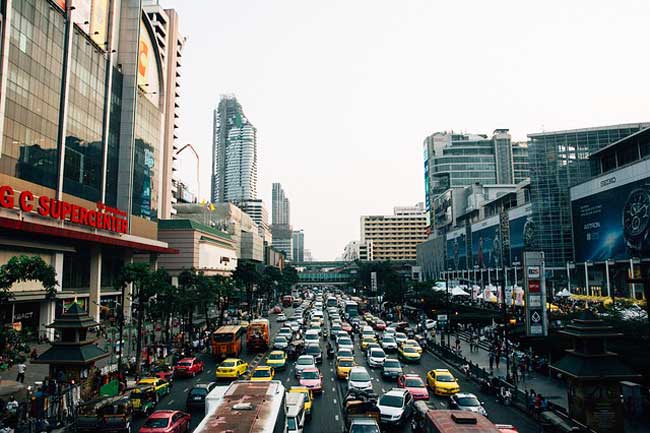
Oftentimes you won't have to worry about driving in Bangkok, because the traffic doesn't move!
5. Lane Switching
If you have been taught to drive properly, you likely check your rearview mirror, wing mirror, and look over your shoulder before changing lanes.
In Thailand, drivers are generally not as diligent when it comes to lane changes.
You will undoubtedly come across individuals who appear to have neglected their mirrors entirely. Many drivers only take a quick glance before switching lanes. Therefore, it is important to remain attentive to the vehicle in front of you, whether it is directly ahead or in the adjacent lanes.
The general rule appears to be that if there is enough space, you can park there, which may lead to some incredibly poor parking examples.
However, be aware of signs indicating “No Parking on Even/Odd Days” or “No Parking from 7-9am.”
Furthermore, curbs with red and white stripes are off-limits for parking.
There are also specific parking areas designated for taxis, motorbike taxis and tuk tuks, so if you're in one of the cities or on one of the islands you need to be aware of that.
Don't panic if you come across cars parked in driving lanes along certain streets. Wider streets with three lanes often shrink to two as people utilize them for parking. This is especially prevalent in Bangkok.
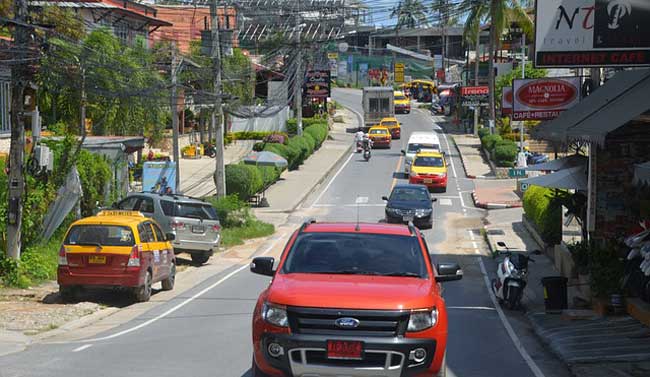
Islands have less traffic but the roads a tad more wild west!
7. Headlight Flashing
In the United Kingdom, it is customary to flash the headlights to indicate that we are allowing another driver to proceed first. As the driver being let through, we often give a flash of the headlights as a way to express gratitude.
However, in Thailand, if someone is flashing their headlights at you, it generally indicates a signal for you to clear the way. This practice also applies on motorways in the UK when someone wants you to change lanes.
——
I'm sure you'll be just fine, but do make sure you have good travel insurance.
+ See My Insurance Recommendations Here
Tips to Start Planning Your Trip:
Book your accommodation.
Book your accommodation for the Mae Hong Son loop at a discounted rate on Agoda
Don’t Forget Travel Insurance
You will need insurance that covers a road trip on a motorbike. I use SafetyWing .
Learn Some Thai
If you plan on sticking around in Thailand for a while, learning Thai is a huge benefit. Get a free account with Thaipod101 here .
GET MY NEWSLETTER
Join thousands of others who receive my monthly roundup of content & insider tips on how to survive & thrive in Thailand.
Last Updated on September 21, 2023
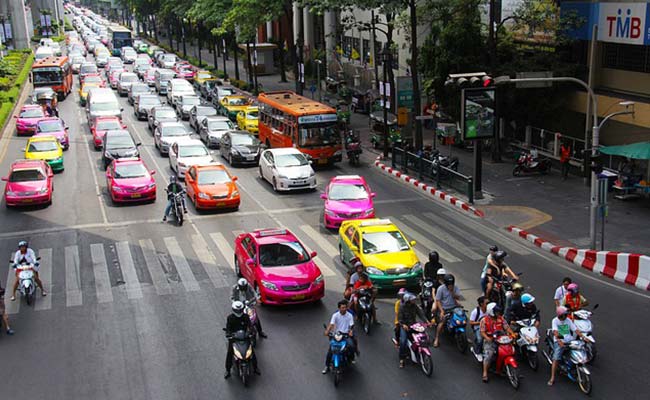
Comments Sort by : newest | oldest
khunwilko says
May 11, 2022 at 6:06 pm
Alex Harris says
September 29, 2019 at 4:54 am
Sep 29, 2019 at 4:54 am
James E says
September 28, 2019 at 10:48 am
Sep 28, 2019 at 10:48 am
TheThailandLife says
September 28, 2019 at 5:08 pm
Sep 28, 2019 at 5:08 pm
Leave a Reply Cancel reply
Your email address will not be published. Required fields are marked *
Notify me when new comments are added.
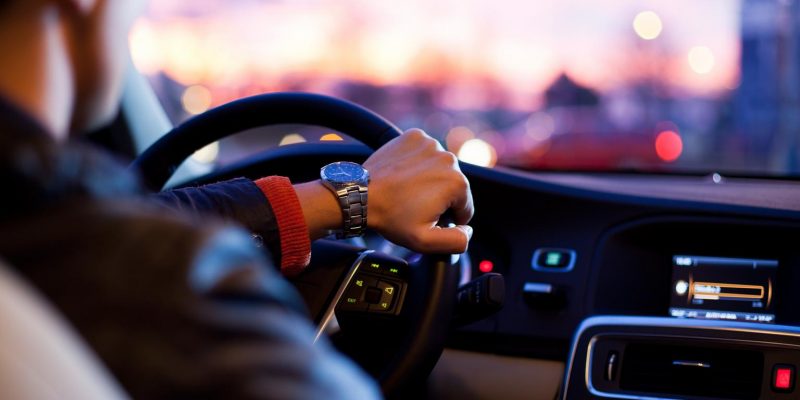
February 27, 2023 in Features , Thailand , Thailand Privilege by Admin
Drive Like a Local: A Foreigner’s Guide To Get Thai Driving License
Driving in Thailand can be a thrilling experience, allowing tourists to explore the country’s distinctive scenery and culture. Foreigners must legally get a Thai driver’s license to operate a motorized vehicle in Thailand. The process of acquiring a Thai driver’s license may seem complicated. Still, this article offers a complete overview of the eligibility criteria, application procedure, and recommendations for passing a written and practical driving exam and the requirements for a driver’s license. It also contains essential information on Thai traffic rules and regulations, road signs and symbols, and insurance requirements for driving in Thailand.
Eligibility Requirements for Foreigners: * Foreigners are required to have a valid passport, visa, or work permit. The visa or work permit must have at least three months remaining, while the passport should have at least six months of validity.
* Foreigners must possess a valid driver’s license from their country of origin
* Foreign nationals must be at least 18 years old to qualify for a Thai driving license. In addition, the minimum age limit for some kinds of vehicles, such as motorcycles, is higher.
* Foreigners are required to get a health certificate from a licensed doctor. The health certificate validates the applicant’s physical and mental fitness to operate a motor vehicle. Additionally, foreign nationals are required to undergo an eye examination and provide confirmation of healthy eyesight.
Here’s the step-by-step guide to getting a Thai driver’s license:
Step 1: Obtain the Required Documents
Before beginning the application process, foreign nationals must provide the required documentation. These documents include a valid passport, valid visa, TM6 departure card, letter address from immigration or work permit, health certificate, and proof of good vision.
Step 2: Visit the nearest Department of Land Transport office After gathering the required documentation, foreigners should visit the Department of Land Transport to apply for a Thai driver’s license. Monday through Friday: Office hours are typically 8:30 a.m. to 4:30 p.m.
Step 3: Submit the Application and Required Documents Foreign nationals are required to submit their application, requirements, and registration confirmation upon arrival at the Department of Land Transport. The registration form is accessible at the Department of Land Transport. The application must either be completed in Thai or English.
Step 4: Conduct the Written and Practical Driving Tests After submitting the application and necessary paperwork, foreigners should take the written and driving exams. The written examination comprises multiple-choice questions covering Thai traffic rules, regulations, and road signs. The practical driving exam is an evaluation of the applicant’s driving skills on a designated course.
NOTE: Individuals who currently hold a valid international license are not required to take written and practical diving tests.
Step 5: Fees and Payments Foreign nationals must pay the necessary fees after passing both exams. The prices vary according to license type and term of validity. A temporary driver’s license costs 200 baht and has a 2-year validity.
After completing those two years on a temporary driving license didn’t get any strikes, an individual can renew the license and upgrade to a personal license which is a five-year validity and costs 500 baht
Step 6: Get a Thai Driver’s License Foreigners will have their Thai driver’s license containing their photo, personal information, and authorized vehicle types.
Tips for Passing the Written and Driving Exams
Tip 1: Study for the Written Examination. The written examination includes traffic rules, regulations, and road signs in Thailand. Foreigners must study the helpful material and practice answering multiple-choice questions to succeed. The Department of Land Transport offers study materials on its website and other online resources.
Tip 2: Preparation for the Practical Driving Examination A practical driving exam is an evaluation of the applicant’s driving abilities on a designated course. Before taking this exam, practicing driving in related courses is recommended. In addition, candidates must be familiar with the vehicle’s controls and comfortable with the car they will use for the exam.
Tip 3: Understand Thai Traffic Rules and Regulations To pass the exams, you must know Thailand’s traffic rules and regulations. In Thailand, driving is illegal while under the influence of alcohol, and obligatory to wear a seatbelt when driving. Before taking the examination, applicants must comply with relevant rules and regulations.
Tip 4: Observe road signs and symbols In Thai traffic, road signs and symbols play a vital role, and it is essential to comprehend their meanings in order to pass the written exam. Applicants should practice recognizing and comprehending the different traffic signs and symbols they may see on Thai roadways.
Tip 5: Be confident and attentive throughout the test It is important to approach both examinations with confidence and concentration. Applicants should maintain composure and concentration throughout examinations, pay strict attention to instructions, and adhere to them precisely. Also, being polite to the examiner and other test-takers is crucial.
Additional Details about Driving in Thailand
Thailand Traffic Rules and Regulation Thailand’s traffic rules and regulations are almost the same as other countries. For instance, driving under the influence of alcohol is unlawful, and violators face severe punishment. All passengers in a vehicle must wear seat belts, and drivers must carry their driver’s license at all times.
Signs and Symbols on Thailand’s Roads Understanding the meanings of Thailand’s road signs and symbols is essential. For instance, the “no parking” sign is a red circle with a diagonal line, although, in other countries, it may be a red rectangle with a diagonal line. Before driving in Thailand, it is necessary to familiarize oneself with the numerous traffic signs and symbols.
Thailand’s Insurance Requirements for Drivers In the case of an accident, all vehicles in Thailand are required to have third-party liability insurance (TPL), which compensates for any damage or injuries caused to third parties. Comprehensive insurance, which covers the vehicle and personal injury, is highly recommended.
Thailand’s Driving Practices Driving in Thailand may vary from driving in other countries, and it is vital to be aware of how other road users operate their vehicles. In Thai highways, motorcycles and scooters are widespread and may maneuver in and out of traffic. It is typically for drivers to use their horns to indicate their presence or to communicate with other drivers.
Securing a Thai driver’s license is easy to obtain. However, foreigners are required to take a driving test and pass written exams which is one of the main requirements to obtain a Thai driver’s license. All foreign drivers are urged to drive safely and adhere to traffic rules and regulations.
If you’re a Thailand Privilege Card member, please contact the member service team directly for assistance at [email protected] . This specialized support ensures that members receive the guidance and help they need for a seamless experience in Thailand.
Stay in Thailand with your family for 5 years or up to 20 years with a Thailand Privilege Card. This visa has been created to make your long-term stay in Thailand hassle-free and convenient. For more information, CLICK HERE .
Leave a Comment Cancel reply
You must be logged in to post a comment.
We’re sorry, this site is currently experiencing technical difficulties. Please try again in a few moments. Exception: request blocked

Thailand Travel Diaries
All About Thailand
How to get a Thai driver’s license
While foreigners with an international driver’s license can legally drive in Thailand, many expatriates opt to apply for a Thai driver’s license since it is valid for a more extended amount of time (typically 5 years) and can also be used as official identification. And because it’s available on your smartphone, you don’t need to bring your ID or driver’s license with you.
Above all, if you want to hire a scooter for a long-term vacation but do not have a European motorbike license, it may be useful. Because scooters and mopeds have at least 125 ccm and are not permitted to be driven with category B permits.
The method is simple in theory and needs a visit to the Department of Land Transport (DLT). But, if you’ve lived in the Kingdom for any length of time, you’ll know that the procedure can be rather bureaucratic, and solid information may be tough to come by – especially if you don’t speak Thai.
Get the necessary documentation. Before traveling to the closest DLT, various paperwork should be prepared. Some of these papers may need you to visit an immigration office. Documents at the time of writing include:
What is needed is:
Passport, visa, and employment reference, if applicable
- A duplicate of the passport and nonimmigrant visa
- A copy of the work permit, if applicable
- A duplicate of the TM 6 departure card
- A letter of address or habitation approved by immigration officials or the embassy
- A medical certificate from a certified clinic or hospital issued within 30 days of application
- A valid driving license from your own country
Note: In addition to the above list, a copy of the passport page showing the last entry stamp in Thailand may be required.
Appointment at the DLT
To avoid standing in line all day, arrange an appointment with the DLT (Department of Land Transport) in advance. The DLT’s Smart Queue website may be used to register and then arrange an appointment for the desired date. Better yet, get the app on your smartphone. (Smart Queue DLT)
If you need a Thai driver’s license urgently and don’t want to deal with Thai bureaucracy or the language barrier, you can employ a private agency to help you secure an appointment. Other paid services are available on the internet, such as B. Thai Driver Service Point…
Visit the DLT for your appointment
On the day of the appointment, you should arrive on time. If you do not already have a driver’s license from your home country, you must complete all of the required tests (described below), as well as a theoretical and practical driving test. Individuals with a driver’s license already can skip the theoretical and practical driving tests.

Tests & Exams
It is recommended that you familiarize yourself with the particular tests in order to be well prepared:
- Color blindness: This test requires you to recognize the color of a lightbulb or lamp in front of you.
- Peripheral Vision: You must identify the color of a traffic light to the right and left while gazing straight ahead without shifting your eyes or head.
- Reflex: When a signal sounds, you must apply the brakes in less than a second while sitting behind a brake and accelerator pedal simulator.
- Depth Perception: A device with two light threads within – one moving and one stationary – emerges in front of you, and you must align them within a set range.
- Theory exam: You must take a multiple-choice test. The DLT website offers an e-learning course as well as practice examinations. (Only applicable to drivers who do not have a valid driving license from their native country.)
- Practical test: You must drive on a tiny course or track outside the test facility and undertake maneuvers like as reversing and/or parallel parking in the main exam. (Only applicable to drivers who do not have a valid driving license from their native country.)
If you passed all the required tests, congratulations! You can now get a Thai driver’s license.
The rates you must pay vary depending on whether you want a 2-year temporary license (about THB 300) or a 5-year permanent license (about THB 600). When you renew your driver’s license, you usually obtain the permanent one.
Digital driving license (app)
The driver’s license holder can exchange their traditional driver’s license for a smart Thai driver’s license, which includes a QR code, at a DLT branch. The new driver’s license may then be scanned using the app and uploaded online to be validated against the DLT database. This is possible using a QR code.
Driving license available
You can even get your driver’s license for the chosen car rewritten if you already have one. The difficulty is that many officials in Thailand’s rural communities and outside of tourist destinations need to be made aware of this. This works well in tourist hotspots like Pattaya and Phuket. It’s not a great effort, but you’ve already spent 12 – 1 day rewriting since you need to collect some paperwork and examine a doctor.
For the issuance of a Thai driver’s license, you need:
- Statement of Certificate of Residence
- Original passport and 1 copy each
- Medical report (you can get it in every practice)
- A valid driver’s license and an international driver’s license are required.
- Recent Posts
- Suan Son Pradipat Beach A Hidden Gem in Rayong Province - June 20, 2023
- Women of Thailand: Empowered and Resilient in the Face of Adversity - June 16, 2023
- Hong Thong: The Popular Thai Spirit You Need to Try - June 15, 2023
Related Posts

Khlong Toei Market – The ultimate guide

Women of Thailand: Empowered and Resilient in the Face of Adversity
Leave a reply cancel reply.
Your email address will not be published. Required fields are marked *
Save my name, email, and website in this browser for the next time I comment.
How to get driving license in Thailand for foreigners
If you hold an ED visa in Thailand or plan to study in Thailand for an extended period of time, a mo torbike or car driving license is extremely useful. It gives you the freedom to go where you want, when you want, and legally as well!
Please see below for a list of the most common FAQs for foreigners who want to get a driving license in Thailand .
Q: Can I get a driver's license on a tourist visa?
Q: can i get a thai driving license with an ed visa, q: what are the lists of required documents for a driving license in thailand.
- Passport with Visa (original and photocopy)
- Original present residence address in Thailand and certification from embassy / immigration bureau ( valid for 1 year) or work permit (with present residency identified) and original photocopy
- Original medical certificate ( 5 diseases form) from clinic or hospital (Valid for 1 month)
- Original and photocopy of valid international driving license (1949 convention) or local driving license (translate into English or Thai language and certify by embassy if it is not in the English language)
Q: How to apply for a motorbike license in Thailand?
A: Applying for a motorbike or car license in Thailand is a relatively easy, if not a time-consuming process, providing you have the necessary documentation. After submitting an application and document, you will wait in the queue for the procedure and tests as follows.
- Take a training 1 hour (Road Safety video)
- Take a physical test (Color Blindness test, Reflex test, Depth Perception test)
- Take a training 5 hours
- Take a theory test (30-minute multiple-choice, requires a 75% pass rate)
- Take a practical test ( you can use your own bike or car, and rent one there for 50 – 100 baht. If you fail, you might be able to try it again a few times on that day base on an examiner’s decision, and if the Queue is an on that day a lot, you might get an appointment to do a practice test again on another day.)
You will generally need to pass a practical and theory test before receiving your license but once you have it, what could be better than cruising the streets after a day learning Thai in class!
Q: How to apply for a car license in Thailand?
A: The process for attaining a car driving license is the same as applying for a motorbike license. The theory test will probably be easier after you learn the Thai language as you will have no need to brush up on your translation skills before the test.
Q: Can I download and print out real test questions?
Q: can i renew a thai driving license online.
A: The mandatory training course for a Thai driver’s license is now available online. The e-learning course is accessible on the website www.dlt-elearning.com, which works with PCs, tablets, and smartphones.
To move on to the physical competency test, get in touch with your local Department of Land Transportation with your result. The period of time starting on the day you pass the test until the driver’s license is issued is 90 days.
The e-Learning lesson is only applicable if the license expires in less than a year or for an early renewal that lasts less than 90 days, so please take note of that.
Alternatively, you can go to local Land Transport Office where you obtained your original license. Normally when you get your first driving license. It’s originally for two years, lasts for two years after that you can renew it, and then renewed license will be for five years. Renew Fee 505 bath at the time of writing.
To renew a driving license, the list of required documents is as follows
- Original 2 years Thai Driving license
- Passport with non-immigrant visa (original and photocopy)
- Original present resident address in Thailand Certify from embassy/immigration bureau ( valid for 1 year) or work permit (with present residency identified) and original photocopy
Q: If I have my own country’s car driving license, Do I need to take a test?
Q: if i already have an international driving license, do i need to test again, q: how much does it cost to obtain a motorcycle and automobile license.
We advise visiting the Department of Land Transport before 8:00 am to submit your application, provide supporting documentation, and obtain your queue if you are applying for a new license. On that day, most tasks will be completed. The next day, you must return for the driving test, hopefully.
Send us a message
Contact information.
10/32 – 10/33 Trendy Office Tower, 1A Floor, Soi Sukhumvit 13, Klongtoey-Nua, Wattana, Bangkok 10110
- +666 1919 7947
- [email protected]
Sign up now to get full access to our online courses.
฿ 29,800.00 Add to cart
Master Class
Writing / reading.
Driving in Thailand
Marco Bottigelli / Getty Images
Though being behind the wheel in any foreign place takes a little getting used to, once you get out of the capital of Bangkok and beyond other big cities—where traffic, tailgaters, and navigating your way around can be challenging—you'll find tropical Thailand in Southeast Asia is actually a pleasant place to drive , as well as a beautiful area with friendly people. Overall, highways in this country are well maintained and serve most of the country, and road customs are not too difficult to understand.
There are many additional transportation options you can make part of your trip, including tuk-tuks (auto rickshaws) , trains, motorcycle taxis, buses, and more. Nevertheless, renting a car in Thailand can be a convenient way to explore the country and will give you more control over where and when you travel.
Driving Requirements
To drive a car in Thailand, you must be 18. If you plan to rent a car, you'll need to be at least 21, though the minimum age varies by company; you will also need to have had a driver’s license for a minimum of a year and carry your passport with you. The driver’s license from your home country might work, especially if it is in English and has a photo.
But since there is a risk of not being covered by insurance, you may want to get an International Driving Permit (an IDP, from your local automobile association). If you are in Thailand for more than six months, you should either have an IDP or a Thai license. Always carry your driver’s license along with your passport when hitting the road—if you forget to bring these documents and are stopped by the Thai police, you can end up with a big fine.
Checklist for Driving in Thailand
- Driver's license (required)
- International Driving Permit (recommended)
- Passport (required)
Rules of the Road
One difference from other parts of the world is that in Thailand, like in the United Kingdom, you drive on the left side of the road, and the driver's seat is on the right, so if you're visiting from the United States or another country where people drive on the right side of the street, initially this may feel awkward. In addition, it's helpful to familiarize yourself with some rules before you set out on the Thai roads.
- Speed limits : On urban roads, the speed limit is usually 60 kilometers per hour (37 miles per hour). Rural roads are 90 kph (56 mph), and on the highway, you may drive a maximum of 120 kph (75 mph).
- Seat belts : Drivers and all passengers are required to wear seat belts. Those who don't comply may get a fine.
- Children and car seats : In modern taxis or cars, car seats may be able to be properly fitted. Unfortunately, older model cars may not have rear seat belts or the correct setup for attaching a car seat.
- Aggressive driving : Be aware that there are differences in driving etiquette before you get behind the wheel in Thailand. Tailgating and cutting people off is much more common and somewhat acceptable.
- Alcohol : The legal blood-alcohol limit for drivers who have had their license for over five years is 0.5 grams per liter of blood. Those breaking the rules may end up with fines and/or prison time.
- Cell phones : Unless you have a hands-free phone, it is illegal to use your mobile phone when driving in Thailand. Not only are there many things to pay attention to as you drive, but if you are using a phone at the same time, you risk getting a ticket and having your license confiscated.
- Petrol (gas) stations : Usually an attendant will fill your tank, take your payment, and clean your windscreen if needed. Credit or debit cards can be used at the bigger gas stations and in most Thai cities and towns, although in some more rural areas only cash is accepted.
- Toll roads : Some of the expressways in Thailand charge inexpensive tolls on roads. The fee is worth it, as the roads help you connect more quickly between the different parts of the country.
- Flashing lights: In Thailand, when a driver flashes their lights, they are letting you know they are not planning to stop and would like you to get out of the way. This is yet another reason to drive defensively.
- Honking : Despite the traffic in some areas, you won't hear frequent honking in Thailand other than some quick, friendly beeps making drivers aware of another driver's presence. However, don't be surprised when locals often honk their horns as they pass shrines or religious areas.
- In case of an emergency : To call the police for a general emergency, dial 191. If you have an accident, the Thailand tourist police 24-hour national call center is reachable by dialing 1155. For ambulance and rescue services, dial 1554.
Road Hazards
Thai road rules are probably much different than you're accustomed to. Since local roads are often filled with unpredictable traffic patterns and motorists, especially in the bigger cities, always be watchful of your surroundings and other drivers.
- Make changes slowly: It helps to change speed or direction slowly and carefully when making a turn or switching lanes.
- Be alert for motorcycles and bicycles: Motorcycles, a common method of getting around in Thailand, will suddenly appear from all directions, zipping in front of you or between cars and sometimes passing dangerously. Likewise, keep an eye out for bicycles.
- Dogs on the road: Since stray dogs sometimes wander into the road (or sleep on the street), keep your eyes peeled.
- Avoid night driving: If possible, avoid driving in the dark, especially in the countryside, as more trucks and vehicles carrying heavy goods typically travel at night, and it's generally harder to see the obstacles in the road.
- Two-way and one-way road changes: Be on the lookout for roads that become one-way roads during certain hours of the day.
Renting a Car
Some major rental car companies operate in Thailand and have offices in the airport and most common tourist areas. There are also local car rental agencies. The cost will vary depending on the location in Thailand, as well as the size and style of the car. Make sure to specify you'd like an automatic car if you are not comfortable driving a stick shift.
All drivers must have third-party insurance at minimum, but it is advisable to have comprehensive insurance. Confirm that your personal car insurance will cover for any accidents or damage that could happen if driving in another country. If you'd prefer to rent a motorbike, you'll have a fun adventure, but you'll need to be aware of certain safety issues .
Typically in the big cities, especially Bangkok, it is difficult to find parking, so you may want to park your car a bit away from the city center and take public transportation to your destination. Many shops, malls, restaurants, and hotels offer parking, and it is typically not expensive (if not free). In very crowded areas—such as Siam Square in Bangkok—drivers are expected to leave their cars in neutral so that they can be pushed out of the way if necessary. Pristine bumpers are difficult to maintain under these circumstances. T
It is illegal to park beside curbs painted red, yellow, or white.
Handy Words to Know
Though some people speak English in Thailand at varying levels, when you are driving and traveling, it comes in handy to know a few key phrases before starting your trip to Thailand.
- Where is the police station?: S̄t̄hānī tảrwc xyū̀ thī̀h̄ịn ?
- I have a flat tire: C̄hạn mī yāng bæn
- I have been in an accident: C̄hạn dị̂ rạb nı kār keid xubạtih̄etu
- Where is ___?: Xyū̀ thī̀h̄ịn ___ ?
- Where can I buy petrol?: C̄hạn s̄āmārt̄h sụ̄̂x n̂ảmạn thī̀h̄ịn ?
Driving in Paris, France
Driving in Asia
Driving in Arizona
Driving in Finland
Driving in Peru
Driving in Cancun
Driving in Italy
Driving in Argentina
Driving in Paraguay
Driving in Australia
Driving in Borneo
Driving in Jamaica
Driving in Portugal: What You Need to Know
Driving in Scandinavia
Driving in Denmark
Driving in Wales
Phone: 081 653 5788 | Email: [email protected]

Obtaining a Driving License in Thailand, for foreigners
December 27, 2023
Thai Solutions
Introduction If you’re an international student with an ED visa or plan to stay in Thailand for an extended period, getting a motorbike or car driving license can be a game-changer (not sure?
Here are answers to common questions for foreigners interested in obtaining a driving license in Thailand:
Q: Can I Get a Driver’s License on a Tourist Visa?
A: Yes, it’s possible to obtain a Thai driver’s license on a tourist visa, but having a non-immigrant visa increases your chances significantly.
Q: Can I Get a Thai Driving License with an ED Visa?
A: Yes, you can. If you’re studying at an accredited language center with an ED Visa, the process is the same as for other foreigners on non-immigrant visas. Your specific visa type doesn’t matter; you just need a valid passport with a visa.
Q: What Documents Are Required for a Driving License in Thailand?
A: To apply for a driving license in Thailand, you’ll need:
- Passport with Visa (original and photocopy)
- Original proof of residence address in Thailand, certified by the embassy/immigration bureau (valid for 1 year) or a work permit (with present residency identified) and a photocopy
- Original medical certificate (5 diseases form) from a clinic or hospital (valid for 1 month)
- Original and photocopy of a valid international driving license (1949 convention) or a local driving license (translated into English or Thai and certified by the embassy if not in English)
Q: How to Apply for a Motorbike License in Thailand?
A: Applying for a motorbike or car license is straightforward if you have the necessary documentation. The process involves the following steps:
- Watch a 1-hour Road Safety video.
- Take a physical test (includes a Color Blindness test, Reflex test, and Depth Perception test).
- Attend a 5-hour training.
- Pass a 30-minute multiple-choice theory test (75% pass rate).
- Take a practical test (using your own bike or renting one for 50 – 100 baht). You may have multiple attempts in a day, based on the examiner’s decision and availability.
Q: How to Apply for a Car License in Thailand?
A: The process for obtaining a car driving license is the same as applying for a motorbike license. Learning the Thai language may make the theory test easier, as you won’t need to translate questions.
Q: Can I Download Real Test Questions?
A: It’s possible, but not recommended, as test questions may vary. The software used for generating questions undergoes updates. Generally, the questions are not overly challenging, and common sense should help you pass comfortably.
Q: Can I Renew a Thai Driving License Online?
A: Yes, an e-learning course for a Thai driver’s license is available on the website www.dlt-elearning.com . You can complete the mandatory training online and then contact your local Department of Land Transportation for the physical competency test. The e-learning option is applicable for licenses expiring in less than a year or early renewals lasting less than 90 days. Alternatively, you can renew your license in person, with a fee of 505 baht at the time of writing.
Q: Do I Need to Retest If I Have My Own Country’s Driving License?
A: If you’re only exchanging licenses, you’ll undergo basic tests for eyesight and reaction. However, if you don’t have a motorcycle driving license and need to add it, you may have to take a computer-based basic test and possibly a driving test. This process usually takes about six hours for both car and motorbike licenses.
Q: Do I Need to Retest If I Have an International Driving License?
A: Yes, even if you possess an international driving license, you’ll be required to take tests for color blindness, peripheral vision, reflexes, and depth perception. However, you won’t need to take the theory and practical driving tests. You’ll receive a two-year temporary driving license, which can be extended to five years.
Q: How Much Does It Cost to Obtain a Motorcycle or Car License?
A: At the time of writing, the cost to apply for a car license is 305 THB, and for a motorcycle license, it’s 105 THB.
Additional Tips To streamline your application process, visit the Department of Land Transport before 8:00 am, submit your application, provide supporting documents, and secure your queue number if you’re applying for a new license. Most tasks can be completed on the same day, with the driving test scheduled for the following day.
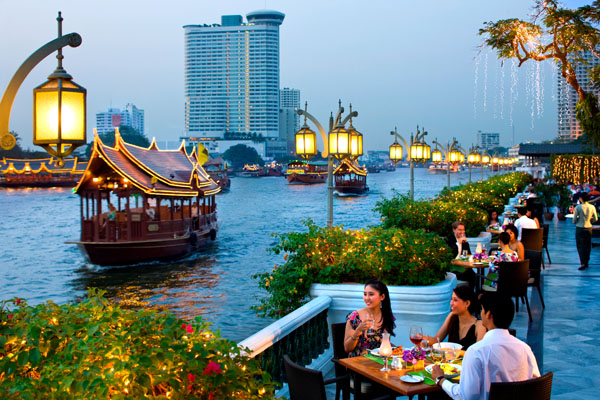
Start Your New Life in Bangkok
Kickstart your life in Bangkok with an Education Visa for 3 months to a year.
Questions? Just Ask!

Have any questions? Feel free to ask!

Phone: (+66) 081 653 5788
Room 128/206, Phaya Thai Plaza Building, 19th Floor, อาคาร, Phaya Thai Rd, Thanon Phaya Thai, Ratchathewi, Bangkok 10400
Office Hours : Monday – Friday 10.00 a.m. to 17.00 p.m. Class Hours : Monday – Friday 10.30 a.m. to 16.00 p.m.
© Copyright Thai Solutions. By InfiniteDrip.

How To Get Driving Licenses in Thailand for Foreigners
by Ms. Sofiya Sarinthip | Last updated Aug 25, 2022 | Published on Aug 10, 2022 | Blog | 0 comments

Thailand has a modern road network system that traverses the country. Thailand also has a lot to see and do, meaning people staying in the country are likely to use the roads to travel. You will also find taxis, buses, and other transportation that will take you where you like in comfort.
However, many people prefer the freedom of having their own transportation, whether it’s for work or pleasure. With your own vehicle, you get to decide your own departure dates and times and your own destinations, and you are free to stop off along the way as frequently as you please.
While Thailand does allow foreigners to drive, they must first have a driving licence, just like every other country. This article looks at how foreigners can get a Thailand driving licence , and other factors to bear in mind.
International Licenses
You won’t need to get a Thai driving licence if you have a valid international driving licence. An international driving licence will let you drive anywhere in the country, and the police and other authorities are known to accept them.
However, it should be noted that a non-Thai national driving licence will not be accepted. For example, if you’re British and have a British driving passport, you must get an international or Thai licence to drive.
Getting a Thai Driving Licence
Foreigners can apply for a Thai driving licence while in the country. The licences are issued by the Department of Land Transport which has offices located throughout the country. You can also apply for a Thai driving licence through a government-approved driving school. However, you should make an appointment first to ensure you get a place because some test centres can get very busy.
You will need to meet certain criteria to qualify for a Thai driving licence, including:
- ID – You must have a valid ID with you. For foreigners, this will usually mean your passport, which must also contain a valid visa.
- Age – For anybody to drive legally in Thailand, they must be 18 years old or above.
Note that you should also try to arrive at the test centre early. Getting a licence can involve a lot of waiting around, but you will be given your licence within the same day in most cases.
To help make things easier, you can pay an agency to help you with the paperwork and other arrangements. An agency may also be able to help you prepare for the test. Remember that while an agency can do some of the work for you, they don’t get to choose whether or not you qualify for a driving licence.
Depending on your country, the test is probably easier than you are used to. The test will also be broken down into two sections: Written and practical.
The practical test involves answering questions in a multiple-choice format. The questions are usually quite self-explanatory, and most people who already drive should be able to pass with no further coaching.
While you might expect to have to pass your test on the roads, that’s not always the case in Thailand. Instead, applicants are expected to drive their vehicle around a pre-designed circuit that simulates stops, junctions, and other road features. Just pay attention to the markings on the circuit, stop and react accordingly, and you should pass with flying colours.
The Licence
In most cases, you will be given your licence on the day. The licence will be made from a printed, laminated card that’s durable enough, provided you keep it in a safe place. You are free to drive on Thai roads as soon as you receive your licence, provided you meet the other criteria.
You must be insured to legally drive on Thai roads even if you do have a licence. If you are caught driving without insurance in the country, then you could find yourself in trouble with the authorities. You could also end up having to pay for repairs and damages if you have an accident.
Many tourist destinations rent cars to holidaymakers, and it is important to ensure these rental companies offer insurance. In many cases, a rental company will ask for ID (potentially keeping your passport for security) and nothing else.
While a rental company might let you rent one of their cars, it does not mean you are legally entitled to drive on the road. If you are caught driving a rental vehicle without a licence and insurance, your vacation may be caught short.
Thai Road Laws
It should come as no surprise that any foreign driver is expected to abide by Thai road laws. Such laws include no speeding, no drinking while under the influence, obeying road signs, and so on. Some foreigners might become complacent because of the often lackadaisical approach Thai authorities often seem to take to enforcing the law. However, the police are well within their rights to arrest you should you break the law, and many foreigners have found at their peril.
Having your own car will help give you more freedom and help you see more of the incredible country that is Thailand. Of course, you will need to abide by the Thai road laws, which include having a valid driving licence.
If you don’t have an international licence, you will need to obtain a Thai driving licence, which is thankfully fairly easy to do. You will need to take a driving test, which most people should be able to pass with ease if they already know how to drive. A Thai driving licence is also very affordable and will often be given on the same day.
Plus, of course, you will need to obey other Thai road laws, and you must be insured.
If you would like more information on getting a Thai driving licence or you need with anything else related to staying in Thailand, the team at Thai Visa Expert is happy to help.

With over 15 years of experience in Visa Services in Thailand, Sofiya’s knowledge and personalized approach have made her a trusted advisor for individuals and businesses navigating Thailand’s visa system. Sofiya’s blog posts offer valuable insights and up-to-date information, solidifying her reputation as an expert in Thai immigration services.
Recent Posts
- TM 30 Reporting – A Quick Guide for 2023
- Retirement Visa Vs Marriage Visa – Which is Best?
- Is it Possible to Work on a Marriage Visa?
- 5 Ways to Extend Your Stay in Thailand
- Retirement on a Budget: Living Well in Thailand without Breaking the Bank
Recent Comments
Privacy overview, exempt visa stamp back to 30 days.

45 days Exempt visa stamp is no longer offered which was implemented on October 1 st last year 2022 as an effort to help stimulate the Thai Tourism Industry. All the countries that eligible for Exempt Visa stamp will now get only 30 days upon arrival.
For those who want to stay longer for tourism purpose, travelers can also apply for a 60 days tourist visa head of time, which is of course, more costly and requires uploading a variety of documents as most embassies have moved to the e-visa application system., either way, the exempt visa stamp for 30 days and tourist visa for 60 days can extend their stay for another 30 days at the cost of 1900 thb at a local thai immigration in thailand. however, some nationalities may receive extension not more than 7 days on a tourist visa (if not eligible for exempt visa stamp).

Thailand arrival & survival guide
The only guide you need to prepare for a trip to Thailand! Find out about visas, insurance, vaccinations, currencies, SIM cards, airport taxis and loads more.
- Destinations
- Things to do
How to get a driving licence in Thailand
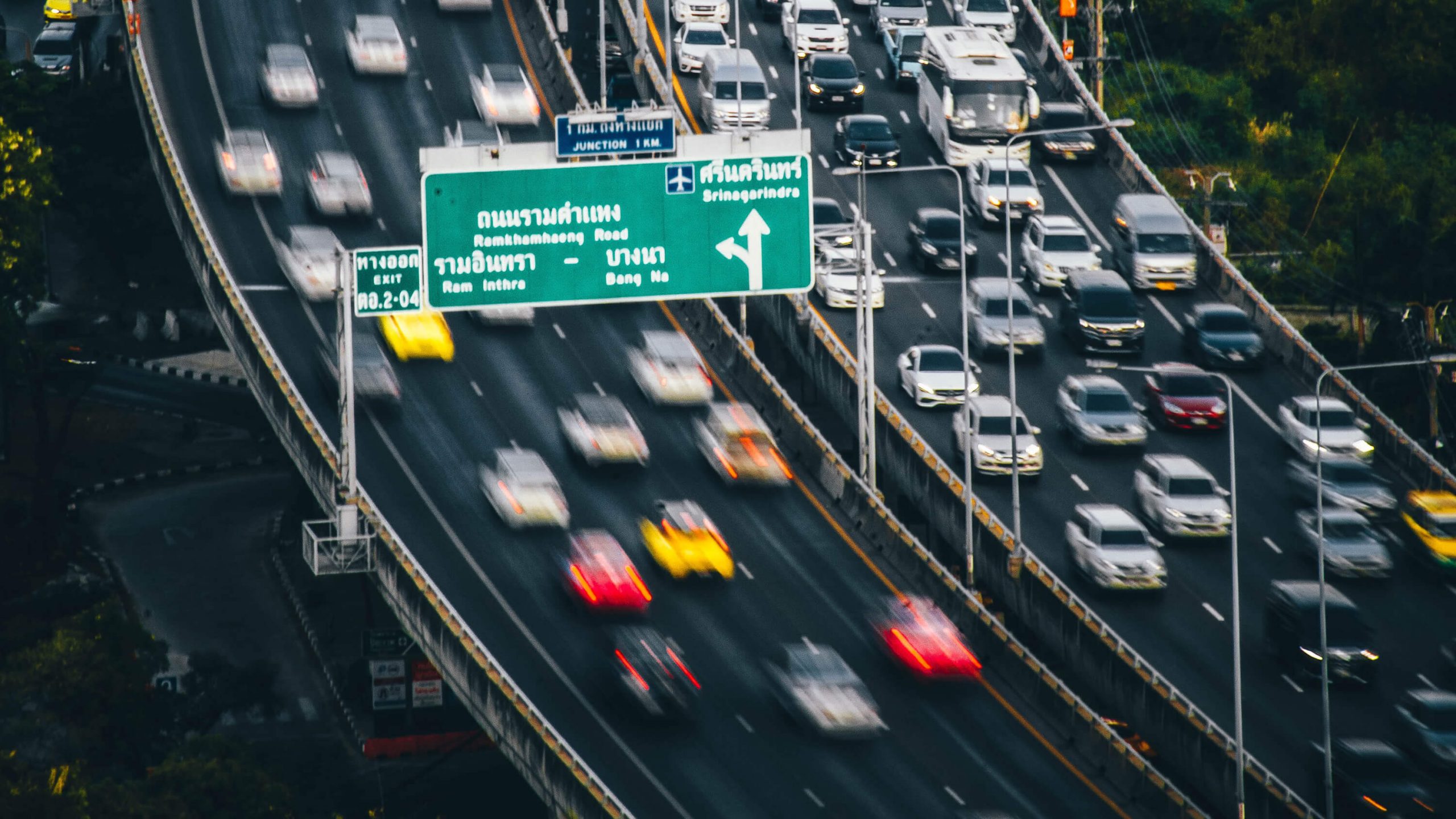
This guide assumes you already have a driving license and/or motorcycle license in your home country. If you’re driving a car or riding a motorcycle in Thailand you need the correct license to avoid on the spot fines but more importantly, be covered by insurance. Unfortunately, your license from back home doesn’t cut it. If you’re just on holiday for up to 2 months, the easiest way to fix this is to apply for an IDP (International Driving Permit). It’s a small document that accompanies your original license. In the UK, this is obtained from the Post Office for £5.50 and expires after one year. If you’re planning to stay in Thailand for a longer amount of time, you may want to consider getting a Thai license. First things first…
Can I get a Thai driving license on a Tourist Visa?
The answer is yes. Regardless of what you read in forums, you can, and it is allowed. I did it when I was a tourist, and I asked in person at the Department of Land Transport. The official answer I was given is that anyone staying longer than 30 days can apply. This means if you’re entering on Visa Exemption, you cannot apply. That said, it will be slightly more difficult because of one document – the ‘Affirmation of Residency’, sometimes called a Residence Certificate. In Bangkok, you’ll find it difficult to obtain this through the immigration office, whilst in Pattaya it’s far easier – more on that later.
Before you head down to your local Department of Land Transportation, you need to gather the correct set of documents.
If you are applying for both a motorcycle and a car license, you need 2 sets of documents .
Here’s what you need to take with you:
- Original passport
- Original driving license (if it’s not in English, it will need to be officially translated.
- Photocopy of the photo page, visa page, your last entry stamp, TM6 departure card (small slip you filled out on arrival). That’s 4 things from your passport.
- Photocopy of your driving license
- Filled out application form
- Original ‘Affirmation of Residence’ certificate (alternatively, a Work Permit can be used). You can use just one original for both licenses , just photocopy the original. But you do need the original!
- Health certificate from a clinic or hospital.
- Application form ( download )
You need to sign the passport copies and the driving license copies, nothing else.
That’s all of the documentation you need. From that list, the only thing that can be frustrating is the Affirmation of Residence. There is usually a place to do photocopies at the Land Transportation offices. There definitely is at Chatuchak. It’s 2 baht per copy just as you enter Building 4 on the right.
Find your Department of Land Transportation
Take Exit 2 from the BTS or Exit 4 from the MRT and walk straight until you arrive at the complex on the left. It’s a big place… bigger than I expected. You are looking for Building 4, signposted อาคาร๔ (aa-kaan sèe<).
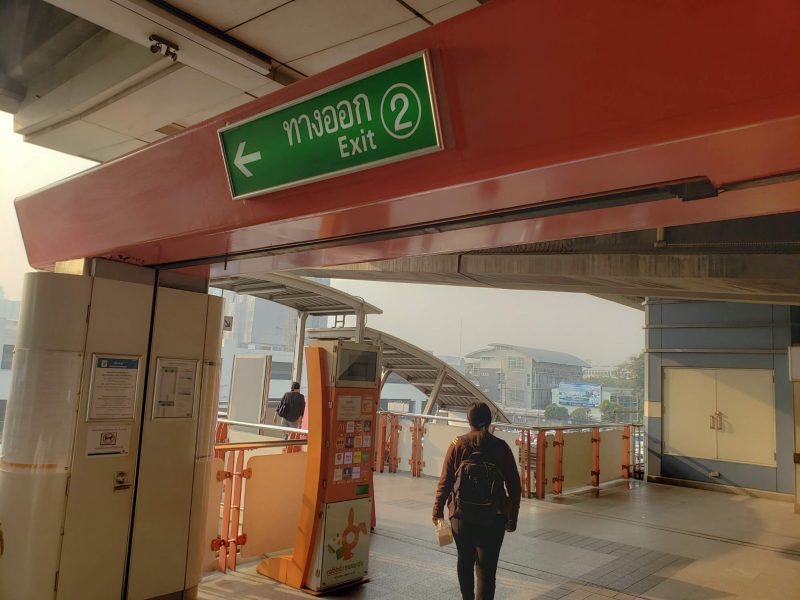
This is the exact location:
My advice is to arrive at 8 or 8:30am. I arrived at 8:30am on a Wednesday and had both of my licences by 12:15pm.
Important: Wear trousers, shoes and a tshirt or shirt!
Don’t do as I did and wear shorts (it was a very hot day) because they will not let you in to the area which you need to take your physical exam. If you did make this mistake, you can buy some Thai size trousers and squeeze in to them at Building 2 for ~200 baht. I did look quite silly for the rest of the day.
After you arrive
I’m going to assume you’re applying in Chatuchak – but it should be similar for other offices.
If you need to do any photocopies, get this done now.
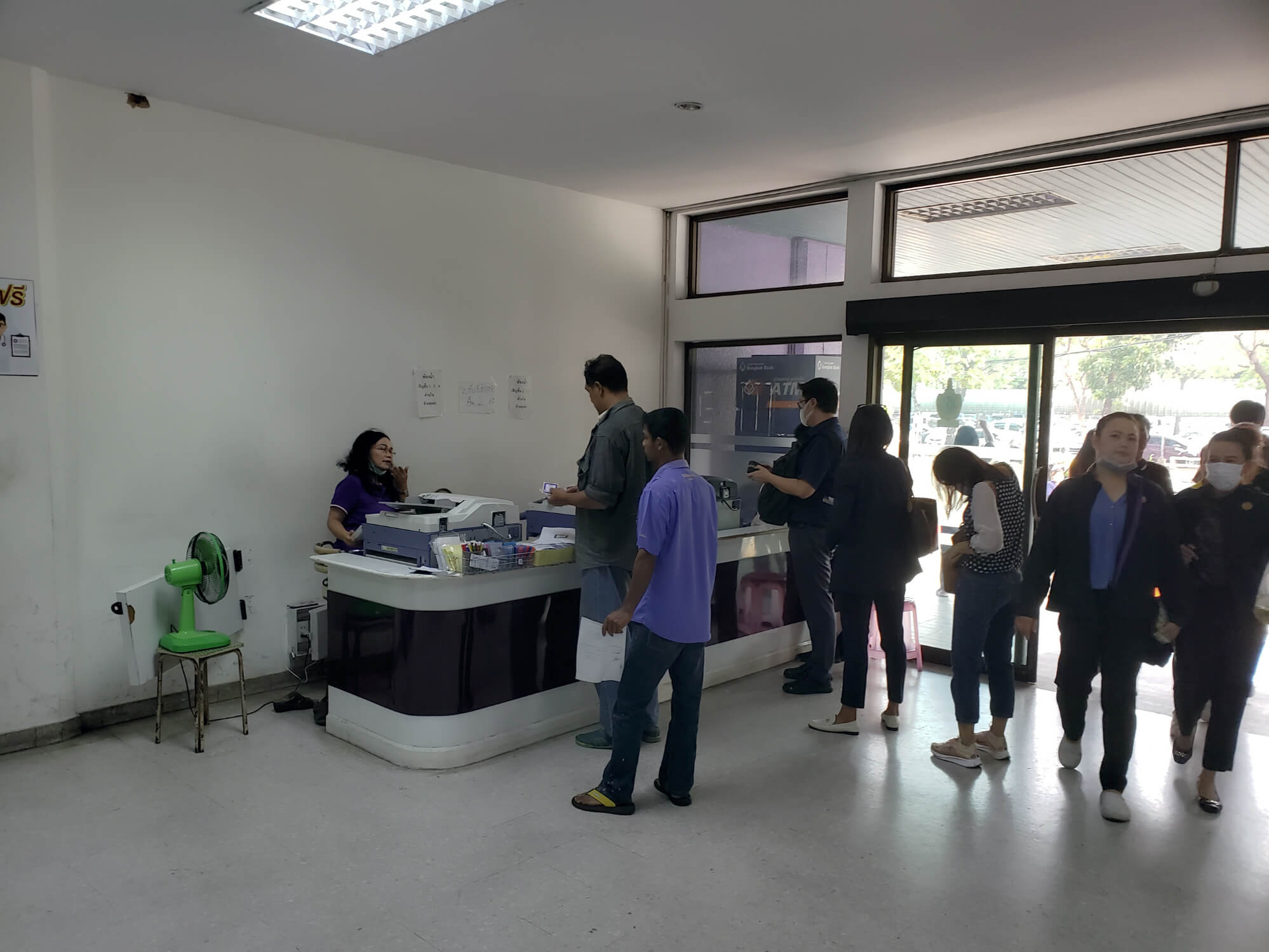
Photocopy service just inside the entrance
You need to get a Head to Floor 2 – you should see a few queues as in the picture below. Get in any queue – they’ll check your documents and give you a queue number. After you have your queue number, sit down near a screen and keep a look out for your number. When it’s called you’ll be seen and someone will sit and confirm your address, do some paperwork and hand it back to you.

2nd floor entrance to get queue number
Now it’s time to go upstairs and do your physical exam – it’s very easy.
Physical exam & theory
After you go to Floor 3, approach the desk at the front (this is where you’ll get caught out for wearing shorts). He or she will check your passport and tell you to go sit down and watch the TV. The TV has a video on repeat telling you how to do the physical exam. You’ll sit here until the next group of people are called in. The numbers are called in Thai, so just hand around awkwardly and ask if it’s your turn to go in.
A group of about 20 is shuffled into a room (no photos allowed unfortunately). This room is quite funny, it’s like an obstacle course with a line painted on the floor. Everyone takes turns to do 4 different little tests. First, there’s a lady with a traffic light with red green and orange – you have to shout the colors that are showing as she changes them – then within seconds you’re whisked away to test 2.
Test 2 is a perception test. You sit down and have to press a button to line up two sticks within an inch of each other. Test 3 is a reaction test. You’ll sit in a chair with your foot on an accelerator and when the light turns red you have 0.75 seconds to get your foot on to the brake – I’d be surprised if someone manages to fail this. On to Test 4, this is a peripheral vision test. You put your head on to a device, look straight forward and shout out the colors that appear to the left and right of your vision. Physical exam done. You should be told to go to Floor 4. Go up the stairs and approach the booth on the right, the lady will tell you which room number to go in for the theory video.
You’ll enter a small classroom with a few people, watch a video for what could have been an hour or more, then leave. Half of it is in Thai with no subtitles, the other half has English subtitles and it just talks about the speed limits and common reasons for accidents.
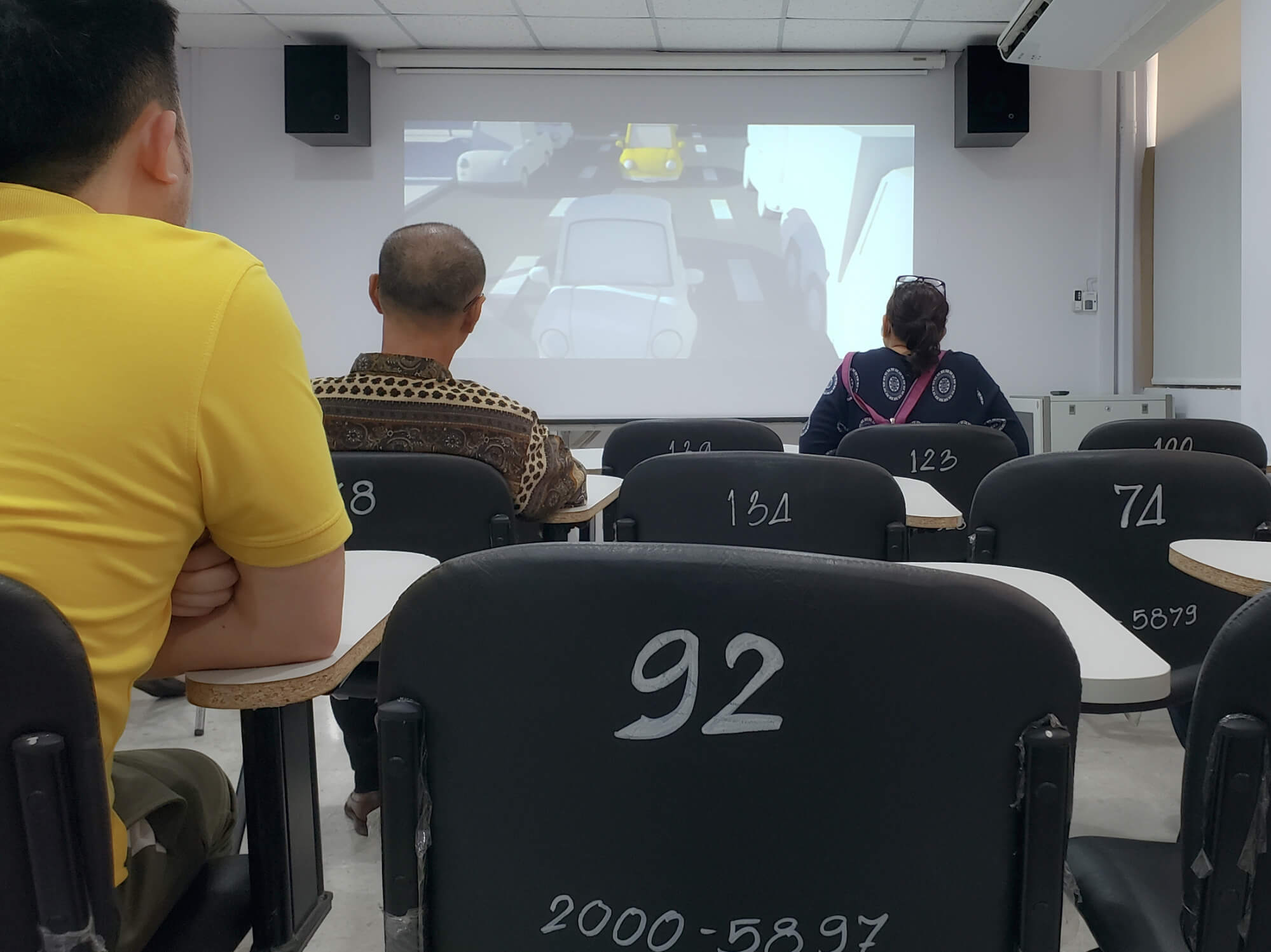
Getting your licence(s)
After the theory video, you’re sent back down to Floor 2 with another number. When your number is called, go to the booth. He/she will check your documents again, confirm your name and address, take your photo and print your card. This is where you pay. I applied for both car and motorcycle licence at the same time, the cost was 305 baht.
Start a conversation
Contact us privately with a DM, or send a public Tweet.

How to get a Driver’s License in Thailand as an Expat
This article provides a comprehensive guide on how expats can obtain a driver’s license in Thailand. It covers the types of driver’s licenses available in Thailand, eligibility criteria, and the documents required to obtain a license. Additionally, the article outlines the steps required to obtain a driver’s license, including obtaining a non-immigrant visa, getting a medical certificate, attending a driving school, taking the written and practical driving tests, and finally obtaining the driver’s license. The article also provides tips for expats seeking to obtain a driver’s license, such as learning Thai language, understanding the traffic rules and regulations, and being patient while driving. Finally, the article concludes by highlighting the importance of obtaining a driver’s license in Thailand and offering some final thoughts and recommendations.
Introduction
If you are an expat living in Thailand, getting a driver’s license is an essential part of settling into your new life. Not only does it give you the freedom to explore the country on your own, but it also serves as a valid form of identification. However, the process of obtaining a driver’s license in Thailand can be quite different from what you may be used to in your home country. In this article, we will provide a brief overview of the process of getting a driver’s license in Thailand as an expat, as well as the importance of having a driver’s license in Thailand. By the end of this article, you will have a better understanding of what is required to obtain a driver’s license in Thailand and how it can benefit you as an expat.

Requirements for Obtaining a Driver’s License in Thailand
Before you can obtain a driver’s license in Thailand, there are a few requirements you must meet. These requirements may differ depending on your nationality and residency status, but in general, they include the following:
Types of driver’s licenses available in Thailand:
- Non-Commercial Driver’s License (Category “F”): This license allows you to drive non-commercial vehicles.
- Commercial Driver’s License (Category “T”): This license is required if you plan to drive commercial vehicles.
Eligibility criteria for obtaining a driver’s license in Thailand:
- You must be at least 18 years old.
- You must have a valid non-immigrant visa.
- You must be physically and mentally fit to drive.
- You must attend a driving school and pass the written and practical driving tests.
Documents required for obtaining a driver’s license in Thailand:
- Passport with a valid non-immigrant visa.
- Work permit or certificate of residence.
- Medical certificate from a licensed Thai physician.
- Certificate of completion from a driving school.
- Valid driver’s license from your home country (if applicable).
- Two passport-sized photos.
Note that the above requirements are subject to change and may differ based on your specific situation. It’s best to check with your local Department of Land Transport (DLT) office for the most up-to-date information.
Steps to Obtain a Driver’s License in Thailand
Obtaining a driver’s license in Thailand involves several steps. Here’s an overview of the process:
Step 1: Obtain a valid non-immigrant visa
Before you can apply for a driver’s license in Thailand, you must have a valid non-immigrant visa. This visa allows you to stay in Thailand for an extended period of time and is typically issued to foreign workers, students, and retirees. You can obtain a non-immigrant visa from a Thai embassy or consulate in your home country or apply for one in Thailand through the Immigration Bureau.
Step 2: Get a medical certificate
Before you can attend a driving school and take the driving tests, you must obtain a medical certificate from a licensed Thai physician. This certificate confirms that you are physically and mentally fit to drive.
Step 3: Attend a driving school
To obtain a driver’s license in Thailand, you must attend a driving school approved by the Department of Land Transport (DLT). The driving school will provide you with the necessary training and instruction to pass the driving tests.
Step 4: Take the written and practical driving tests
Once you have completed the driving school program, you must take both a written and practical driving test. The written test covers Thai traffic laws, road signs, and driving regulations, while the practical test assesses your ability to drive on the road.
Step 5: Obtain your driver’s license
If you pass both the written and practical driving tests, you will be issued a temporary driver’s license. You can then visit the DLT office to obtain your official driver’s license. The license is typically valid for two years and must be renewed thereafter.
Note that the process of obtaining a driver’s license in Thailand can be time-consuming and may require multiple visits to the DLT office. It’s important to be patient and persistent to ensure that you meet all of the requirements and obtain your license successfully.

Tips for Expats Seeking to Obtain a Driver’s License in Thailand
Obtaining a driver’s license in Thailand can be a challenging process for expats, especially if you’re unfamiliar with the local language and driving customs. Here are some tips to help you navigate the process and become a safe and responsible driver in Thailand:
Learn Thai language
While it’s possible to obtain a driver’s license in Thailand without speaking Thai, knowing the language can be a huge advantage. It can help you communicate with driving instructors, understand road signs, and navigate through traffic more effectively.
Understand the traffic rules and regulations in Thailand
Thailand has its own unique set of traffic rules and regulations that may differ from what you’re used to in your home country. It’s important to study and familiarize yourself with these rules to ensure that you’re driving safely and legally.
Be patient and calm while driving
Driving in Thailand can be chaotic, with heavy traffic, aggressive drivers, and a lack of lane discipline. It’s important to remain patient and calm while driving and avoid getting caught up in road rage incidents. Remember that safety should always be your top priority.
By following these tips, you can improve your chances of obtaining a driver’s license in Thailand and become a confident and skilled driver on Thai roads.
Obtaining a driver’s license in Thailand as an expat can be a challenging but rewarding process. It requires meeting certain eligibility criteria, attending a driving school, and passing both a written and practical driving test. Here’s a recap of the requirements and steps:
- Obtain a valid non-immigrant visa
- Get a medical certificate
- Attend a driving school
- Take the written and practical driving tests
- Obtain your driver’s license
Having a driver’s license in Thailand is essential for expats who want to drive legally and safely on Thai roads. It allows you to explore the country at your own pace, travel more conveniently, and access remote areas that are difficult to reach by public transportation.
In conclusion, obtaining a driver’s license in Thailand is a process that requires patience, persistence, and a willingness to learn. By following the eligibility criteria and steps, learning Thai language and traffic rules, and remaining patient and calm while driving, you can become a confident and responsible driver in Thailand.
To learn more about relocating to Thailand as a digital professional, download the free Shelter ebook!

We've detected unusual activity from your computer network
To continue, please click the box below to let us know you're not a robot.
Why did this happen?
Please make sure your browser supports JavaScript and cookies and that you are not blocking them from loading. For more information you can review our Terms of Service and Cookie Policy .
For inquiries related to this message please contact our support team and provide the reference ID below.

IMAGES
VIDEO
COMMENTS
Requirements of getting a driving license in Thailand are quite similar to many parts of the world. You can make a Thai driving license at any Department of Land Transport Office. You must be at least 18 years old, in good physical and mental health, and have knowledge of both driving and the driving laws in Thailand.
Eligibility for an international driving license in Thailand requires a valid national license, appropriate age, and residency status. Necessary documents include a valid passport, current driving license, photographs, and possibly a translation. The application process involves submitting documents at a DLT office, completing a form, and ...
Step 1: Obtain a Non-Immigrant Visa. To qualify for a Thai Driver's License, you must first be on a non-immigrant visa. Put simply, this is a type of visa that gives you permanent residency in Thailand. Examples of this are education visas in the Kingdom as well as visas that go along with a work permit.
6 minutes ago, Ramanathan.P said: Those on tourists visa cannot get any driving license in Thailand. You can obtain the 2-year temporary Thai driving licence as a tourist, but not the 5-year licence without Non Immigrant status. Try a different…
License Requirements for Foreigners . If a foreigner is staying in Thailand on a tourist visa then by law a driver should have carry their National Drivers License (in English or translated to English), and an International Driving Permit (obtained easily in your home country - if your country qualifies). Some sources state a National Driving License will suffice, however, following advice ...
The foreign licence must either be in English, or be accompanied by an official translation into English or Thai. The licence needs to have been issued by a country that has a treaty with the Thai government allowing the mutual acceptance of driving licences. Most countries, including Australia, Canada, New Zealand, the UK and the USA have this ...
However, you are required to have some form of identification with you, such as a photocopy of your passport's main page or a digital copy on your smartphone, or your driver's license. However, it is important to note that if you are driving a vehicle in Thailand, you must carry your original passport or a certified copy of it while on the road ...
Step 2: Visit the nearest Department of Land Transport office. After gathering the required documentation, foreigners should visit the Department of Land Transport to apply for a Thai driver's license. Monday through Friday: Office hours are typically 8:30 a.m. to 4:30 p.m.
Step 1: Check your eligibility. In order to acquire an International Driving Permit (IDP) in Thailand, it is imperative to fulfil certain legal requirements. These include: Minimum of 18 years old. Possessing a valid driver's licence from your home country.
Thailand has strict laws concerning driving under the influence: 1. The legal blood alcohol limit for regular drivers is 0.05%. For professional and new drivers (those who've had their license for less than 2 years), the limit is 0.02%. 2.
BANGKOK. If you reside in Bangkok you may contact the Department of Land Transport (Tel: 02-271-8888) or another branch office nearest your location. Branch Office Area 1, Bangkhuntien. Tel: 02-415-7337. Branch Office Area 2, Talingchan. Tel: 02-882-1620 through 1635. Branch Office Area 3, Sukhumvit 62 Road. Tel: 02-332-9691 through 9694.
The driver's license holder can exchange their traditional driver's license for a smart Thai driver's license, which includes a QR code, at a DLT branch. The new driver's license may then be scanned using the app and uploaded online to be validated against the DLT database. This is possible using a QR code. Driving license available
If you hold an ED visa in Thailand or plan to study in Thailand for an extended period of time, a motorbike or car driving license is extremely useful. It gives you the freedom to go where you want, when you want, and legally as well! Please see below for a list of the most common FAQs for foreigners who want to get a driving license in Thailand.
A driver's license issued by another ASEAN member country. In case the person's license cannot be used in Thailand, a temporary driving license must be obtained from the Provincial Land Transport Office in the province where the traveller has entered. To apply for a temporary driving license (valid for 30 days), the following documents must ...
Driving Requirements. To drive a car in Thailand, you must be 18. If you plan to rent a car, you'll need to be at least 21, though the minimum age varies by company; you will also need to have had a driver's license for a minimum of a year and carry your passport with you. The driver's license from your home country might work, especially ...
The Thai driving license exam has 5 different categories: 1.Vehicle Law. 2.Road Traffic Law. 3.Traffic and Warning Signs. 4.Safe Driving. 5.Vehicle Maintenance. The driving license exam is divided into 2 sets of questions, with each set consisting of 25 questions (50 questions in total.)
When you're looking to obtain a Thai driving license, the process varies slightly depending on your status in the country.Whether you're a tourist, an expat, or a resident, there are options and specific steps to follow to ensure you're legally allowed to drive on Thai roads.. Temporary and personal licenses: Initially, most foreigners start with a temporary driver's license.
A: To apply for a driving license in Thailand, you'll need: Passport with Visa (original and photocopy) Original proof of residence address in Thailand, certified by the embassy/immigration bureau (valid for 1 year) or a work permit (with present residency identified) and a photocopy. Original medical certificate (5 diseases form) from a ...
Getting a Thai Driving Licence. Foreigners can apply for a Thai driving licence while in the country. The licences are issued by the Department of Land Transport which has offices located throughout the country. You can also apply for a Thai driving licence through a government-approved driving school. However, you should make an appointment ...
Here's what you need to take with you: Original passport. Original driving license (if it's not in English, it will need to be officially translated. Photocopy of the photo page, visa page, your last entry stamp, TM6 departure card (small slip you filled out on arrival). That's 4 things from your passport.
Steps to Obtain a Driver's License in Thailand. Step 1: Obtain a valid non-immigrant visa. Step 2: Get a medical certificate. Step 3: Attend a driving school. Step 4: Take the written and practical driving tests. Step 5: Obtain your driver's license.
Formula One is a sporting empire complete with rock star drivers, billion-dollar teams and a carbon footprint equal to a small African country. Formula E, its all-electric counterpart, is just a ...